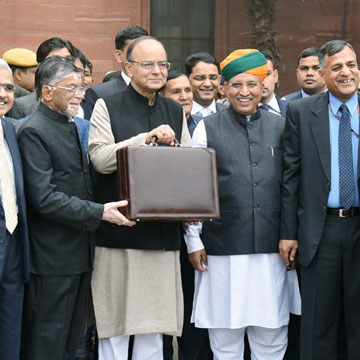 New Delhi:
New Delhi: Prime Minister Narendra Modi swept to power in India in May 2014 ardently promising -- like so many chest-thumping leaders elsewhere in the world -- that he would create jobs. The angry and under-employed young people of heavily populated north India, in particular, decided to trust a man who sold himself as a strong, sound steward of the economy.
But if you listened to his government’s fourth annual budget this week, you’d think a totally different Modi had been elected. In India, the budget is meant to be a roadmap to economic policy, not just a statement of accounts. This one, however, was little more than an exercise in damage control. The budget had a long list of giveaways and government programs -- needed, perhaps, given how badly the government's decision to withdraw 86 percent of India's currency from circulation has hurt the economy -- but little in the way of genuine, job-creating reform.
India's Aspirations
Palliative and reactive policy isn’t anywhere near adequate, given the scale of the jobs crisis India faces. The baseline challenge is daunting enough: A million young people enter the job market every month. What makes this infinitely worse is how poorly the Indian economy under Modi has done at providing them regular employment. According to the government’s own figures, only 135,000 jobs were created in 2015 -- the lowest total in seven years and 67 percent lower than the number created in the last year of the previous government.
It’s long been known what sort of reforms India needs to create jobs. It needs to open itself up to global supply chains, to incentivize firms to grow so they can compete with their global peers and to work harder on teaching skills to its young people. But these haven't been the Modi government’s priorities.
Consider this: Most Indian companies employ fewer than 70 workers, meaning they don't enjoy the productivity and employment boost that economies of scale can provide. Small firms, according to McKinsey, account for 84 percent of manufacturing jobs in India, compared to 25 percent in China.
Years of coddling these Lilliputian companies, and imposing crippling regulations on larger ones, give firms little incentive to grow bigger. A World Bank study has pointed out that after 35 years, the typical American company sells 10 times as much as it did initially and employs 10 times as many people. In India, however, the productivity of the average 35-year-old firm barely doubles, “while its headcount actually falls by a fourth."
Yet the latest budget once again encourages companies to remain small: The corporate tax rate for small companies was cut to 25 percent, while that for larger companies remained at 30 percent.
Nor has the task of moving India’s young people up the skills ladder been addressed properly. Instead of making human resources a priority, the government has treated it as an afterthought. Confusion reigns: Currently, 20 different ministries run 70 different skills-related programs. A "Skill India" mission was launched with much fanfare in 2015, promising to make 400 million Indians employable in seven years. It managed to reach about 1.76 million in its first year.
Sure, its reach will hopefully expand. But more worrying is this: Of those 1.76 million, only 580,000 completed the course; and of those, only 82,000 could actually be matched to jobs. Part of the reason is that the government is doing a bad job of figuring out what skills the private sector actually needs from its employees. Whether or not officials understand this shortcoming is unclear: The latest budget just added another bunch of skills programs to those that already exist. At least one of these programs intends to assist young Indians “who seek job opportunities outside the country," which is perhaps a realistic view of how well the government’s doing at creating opportunities at home.
Make no mistake: The costs of failure are dire. India’s Chief Economic Advisor, the economist Arvind Subramanian, produced last week a searingly honest view of India’s challenges. In this year’s Economic Survey, Subramanian warned that the demographic dividend -- India’s big youth bulge, the moment that it has to seize if it wants to drag itself out of poverty -- will have peaked by 2020.
A new economic vision, he warned, is needed. If that vision isn’t to be found, then India will waste the second half of its youth bulge the way it’s wasted the first. Today the country is young and energetic, but poor and unskilled. If nothing changes, it will someday be old, tired -- and still poor.
# Source: ET, This article is originally written for the Bloomberg and column does not necessarily reflect the opinion of the editorial board or Bloomberg LP or ET or FnF and its owners.
 New Delhi: Prime Minister Narendra Modi swept to power in India in May 2014 ardently promising -- like so many chest-thumping leaders elsewhere in the world -- that he would create jobs. The angry and under-employed young people of heavily populated north India, in particular, decided to trust a man who sold himself as a strong, sound steward of the economy.
New Delhi: Prime Minister Narendra Modi swept to power in India in May 2014 ardently promising -- like so many chest-thumping leaders elsewhere in the world -- that he would create jobs. The angry and under-employed young people of heavily populated north India, in particular, decided to trust a man who sold himself as a strong, sound steward of the economy.